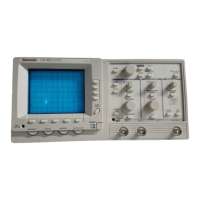TAS 200 Series Specifications
4
Handheld and Benchtop Instruments Basic Service
Table 4: Trigger Characteristics
Characteristic TAS 220 Description TAS 250 Performance Description
Sensitivity
0.5 divisions (internal), 0.1 V (external) DC to 5 MHz DC to 10 MHz
1.5 divisions (internal), 0.2 V (external) 5 to 20 MHz 10 to 50 MHz
2.0 divisions (internal), 0.2 V (external) Video Video
Input Impedance (Typical) 1M, 30 pF
Maximum Input Signal 100 V (DC + peak AC)
Table 5: Typical Z-Axis Characteristics TAS 200 Series
Characteristic Description
Maximum Input Voltage 50 V (DC + peak AC)
Sensitivity 3V
p-p
(Trace becomes brighter with negative input.)
Frequency Bandwidth DC to 5 MHz
Input Resistance 5k
Table 6: Typical X-Y Mode Operation
Characteristic TAS 220 Description TAS 250 Description
Sensitivity Same as CH 1 vertical axis
Sensitivity Accuracy 5 mV to 5 V/div: ±4%
1 to 2 mV/div: ±6%
Frequency Bandwidth DC to 1 MHz DC to 2 MHz
X-Y Phase Difference ≤3° from DC to 50 kHz ≤3° from DC to 100 kHz
EXT HOR Sensitivity 0.1 V/div
Table 7: Typical Probe Compensation Signal Characteristics TAS 200 Series
Characteristic Description
Waveform Positive going square wave
Frequency 1 kHz
Duty Ratio 50:50
Output Level 2V
p-p
Output Resistance 2k
